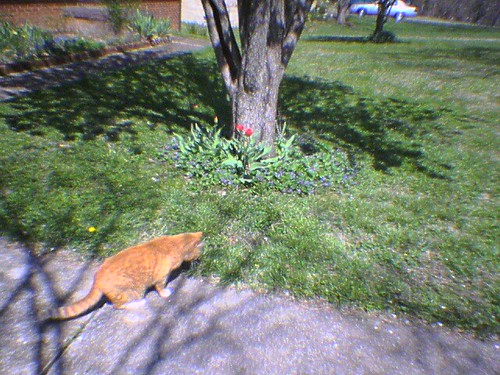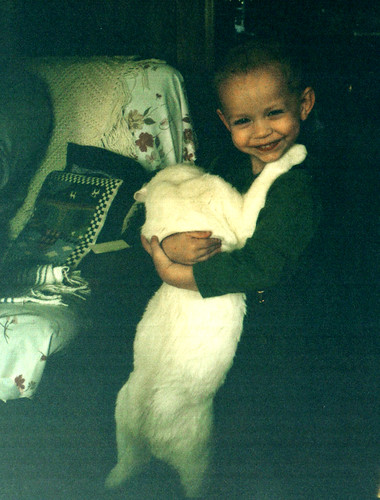
Since it's colder than...well, I'll keep this PG-13...molesasses in January, here's a nice picture of spring. Amon stops to smell the spring flowers. Then eat a few. Then come inside, and puke them up. Uh, next picture.

This is a picture of one of my 2 nephews holding Jammer. This picture is from about 2000, and the quality is as good as it gets (translation, already color-corrected and light-balanced in Photoshop, can't do much else without genuine alteration. Hey, it's an old print, and probably crappy film.). Jammer isn't dead, drugged, or anything else in this picture. He would always go completely limp whenever anyone picked him up. Some kind of passive resistance, or something. He was also very tolerant of kids, allowing them to do whatever they wanted, short of actual bodily harm. Then he would just get up and walk away, or run if they chased him.
Jammer came to my family in June of 1992, 2 weeks after my Papaw died. We found him in Grandma's yard after taking her home from a night out at the drive-in theater. He was only about 2 weeks old, alone, and crying. Lots of loud crying. Grandma had a lot of barn cats at the time, and we figured momma cat was moving the litter, so we left him in the yard. The next morning, Dad, Eirene, and I went to Grandma's and this little white kitten was still in her yard, crying. Momma cat never came back for him. So we scooped him up, and Mom took me to town to get some goat's milk to feed him, and a baby medication dropper. This was back in the day before KMR was available at any pet store, so we had to figure out what would work. Cats are lactose-intolerant, just like me, so I knew what would work and what wouldn't. Goat milk was available in the dairy case of the grocery store, this being rural Indiana, and is very rich, and lactose free. We had kitten formula.
When we got back home, I fed Jammer with the dropper, warming the milk in the microwave. Poor thing was starving. I fed him about 2 tablespoons. He was so little then, that his stomach was visibly full with just that amount of milk. I knew that infant kittens need to be stimulated to have a bowel movement, so I got a washcloth, and started rubbing his tummy with it, simulating a momma cat licking. Then he got a bath, in baby shampoo in the sink, to take care of the fleas. I knew he was way too little for any kind of dip, so the only thing we could do was lather him up in the baby shampoo, then bundle him up in a towel to keep him warm, still with shampoo on him, for about 10 minutes. The shampoo would suffocate the fleas. Then Jammer got his rinse, a good towel drying, and cuddling to keep him warm. Jammer then went to sleep in a blanket-lined box.
Every 2 hours or so, I fed him, and he got a daily bath until the fleas were gone. Every time I fed him, he acted like he'd never eaten before. He would chew on the hard plastic, trying to get the milk faster, and grab at the dropper with his little claws. Eventually, we found a small bottle, so he was able to properly nurse, which was a lot less messy, at least until he bit too many holes in the nipple, then it was time for a new bottle. As the days passed, he grew, and grew, and grew. Each time I fed him, it was so funny to watch. As he suckled, both of his ears would flap forwards and back. The entire time, both ears were going back and forth, as he sucked and his entire scalp moved. Apparently the muscles to suck are attached to the back of the head in cats, or something. It was too funny.
The scarriest moment in Jammers rearing was when I was weaning him to wet food. Mom had bought some canned food that had chunks of "meat" in it. Jammer still thought each meal was going to be his last, so he tucked in like a pro. Suddenly, he ran into the living room, shaking his head. Then he started pawing at his mouth. I realized he wasn't breathing, he was choking. I looked in his mouth, and saw the food. I ran to the bathroom to get the forceps I knew were there, grabbed a pencil from the bejillion laying around, and went to work. I grabbed him, again, forced his mouth back open, holding his bottom jaw open with the pencil - he'd already bitten me twice in panic when I looked inside the first time. Then I reached in with the forceps, grabbed the chunks, and pulled it out. I sat him down, and he coughed up 2 more chunks, then lay down to catch his breath. By the time I pried his mouth open, his gums were already turning blue. He never lost consciousness, but he was close by the time I removed the piece that was choking him. I don't know how many lives he used up, but I know I used 1 or 2 of my own.
Also, that was when I had a pretty good idea I could cut it as an EMT, I didn't freeze up, did what needed to be done. I was a licensed EMT 2 1/2 years later. Never knew anyone could blame being an EMT on a cat, did you?
Jammer lived a good, long life. He passed away last year, at 12 years old. Not bad for a farm cat. He had lost all but 3 of his teeth - the fangs which were chipped - and was arthritic to the point he couldn't jump high anymore. More and more he just wanted to sleep in a nice warm place. One day he decided to go outside, and never came back. I truly think he knew it was his time to go, and he wanted to be alone to meet his maker. The first cat I ever hand-reared, but certainly not the last. There are many, many more stories about Jammer I could tell, which I will eventually get around to on here.
Jammer
1992-2004
He was a good cat.
2 comments:
Wow, I guess there's no Heimlich maneuver for cats huh?
I never would have thought to do what you did - good job!
You probably could have been a good vet too.
Actually there is a way to dislodge food in a pet, such as a cat or a dog, doing a chest thrust. Here's how:
Lay the animal down on one side. Place the heel of your hand on middle of the ribcage. Compress about 1/3 to 1/2 of the total depth of the animal's chest. Do 5 chest thrusts, then open the animal's mouth and look for the food. Repeat until the object is dislodged.
If the animal is unconcious and not breathing, after you look inside the mouth, position the head as if they were sniffing something. The neck should be straight, not bent back at all. Put your mouth over the animal's muzzle, covering both the noze and mouth. Give one puff, just enough to fill the lungs. If the air doesn't go in, reposition the head, and try again.
If the second breath doesn't go in, do 5 more chest thrusts, look in the mouth and remove the object if you see it, then attempt two more breaths. Repeat until you are successful, or until the animal has been without air for about 10 minutes.
Unfortunately, after 10 minutes, the brain has been to long without oxygen, brain death has occured. At that point the only thing you can do is cherish the happy memories you had, and know that you did everything you possibly could.
Post a Comment